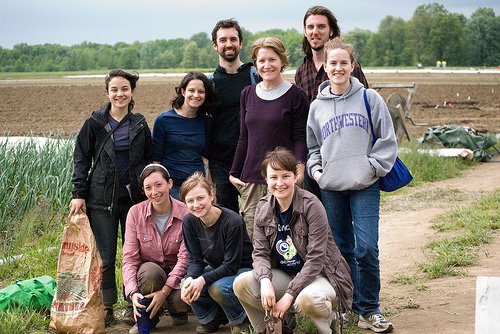Working on a vegetable farm, I live in kind of a vacuum half the year. I make an effort to be in touch with our non-farm friends, to have some contact with the outside world… but the reality is, once the season really gets swinging about the only news I hear are 15 second blips on the truck radio as I drive produce from the field to the cooler. I’m instead tuned into this farmer world of weather and soil, complete with its own peculiar national news and issues. As you may know, a number of our agricultural pests and sicknesses in the northeast overwinter down south and blow up in the summer storms, keenly watched by farmers and growers. This year, the two worlds have crossed a little.
In the 1840s, the Irish Potato Famine killed about a million people in a country of about 8 million. There were various causes that made the Irish so vulnerable, but there was only one villain for the potatoes: Phytophthora infestans, aka Late Blight, the villain of our story. Late Blight is a nasty fungal sickness, spread by spores in the air, that affects tomatoes and potatoes and a few of their cousins. A spore lands on a plant, creates a little black lesion, and within a few days that lesion produces several hundred thousand new spores, which disperse to infect new plants. A single infected plant will produce literally millions of spores in a weekend. The sick plant withers and dies, usually in several days, followed by all his neighbors. Unchecked, a healthy field of tomatoes can be dead in two weeks. There is no cure; there is only death.
Late Blight spores more or less need living plant matter to survive… which means here in the northeast, they die each winter unless they’re allowed to survive in sick potato tubers that were not destroyed, or in greenhouses, etc. Good management means we can be free of the disease in the early part of the season… but later on there is always the risk of it blowing up in storms, or from neighboring gardens or farms. And organic growers have very few tools against fungal diseases—it pretty much begins and ends with copper, a tool many of us aren’t thrilled to use to begin with… and in the best of cases, copper only delays the onset of Late Blight once the pathogen is in your field—it’s just not strong enough to totally shield your plants. And it rinses off in the rain. So you can easily see why, with a disease that you can only vainly defend yourself from, and which will almost surely destroy your entire yield, farmers are a bit edgy about Late Blight.
Which brings me to the intersection of this farmer world and the regular world—This year, during what was already the worst conditions for late blight in a long time (week after week after week of cool rain), a wholesale seedling grower shipped out thousands and thousands of infected tomato seedlings to big box stores like Lowes and Home Depot all over the eastern seaboard. It’s kind of like when a massive decentralized meat industry makes people sick all over the country, except the plants are dying this time. The company taking the rap is Bonnie Plants, from Alabama, but it hardly matters. This has created the earliest and broadest outbreak of Late Blight ever, all over the northeastern USA. Weeks earlier than the usual scattered cases, we’re seeing it reported in nearly every county in New York. As I’ve watched reports of the disease coming in, I’ve slowly become aware of it getting covered in the regular news, too. So hi there, real world—nice to see you midsummer for a change, sorry it’s under such rough circumstances.
At Hearty Roots we’re scouting closely for the disease, hoping it will miss us. We have friends further north who have already begun cutting out sick plants by the hundreds, hoping to eradicate hot spots before the whole field goes. Miriam is spraying copper and keeping a close eye on the situation, and the rest of have our fingers crossed—we love tomatoes and want to eat them! So say a little prayer, and if you’re a home gardener with tomatoes, PLEASE—spend a moment to google this if you’re not in the loop already, and make sure your garden isn’t serving as a stopover for spores on their way further afield.
This is Lukes first year at Hearty Roots!
Tuesday, July 21, 2009
Subscribe to:
Post Comments (Atom)




No comments:
Post a Comment